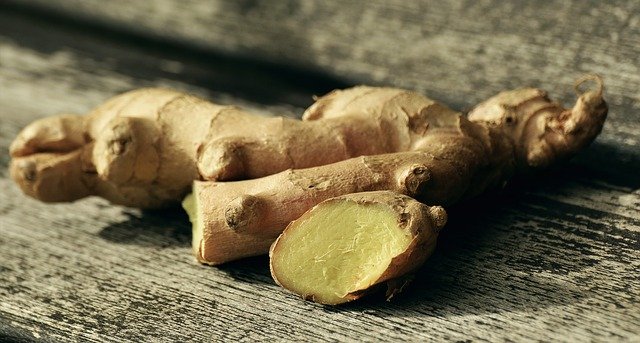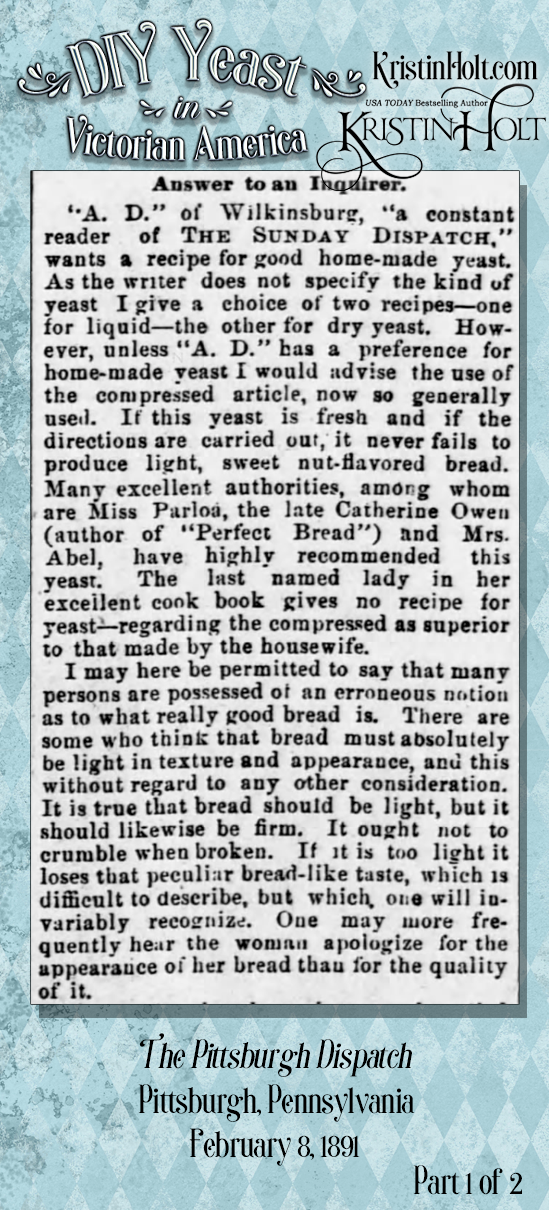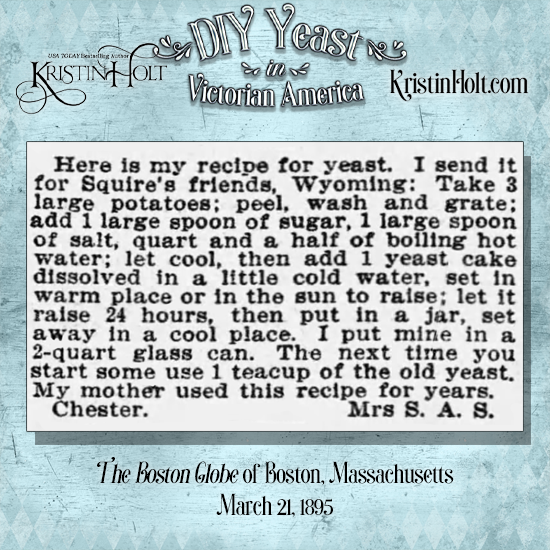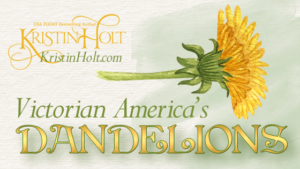DIY Yeast in Victorian America
DIY Yeast in Victorian America
.
Long before factory-prepared yeast was sold in stores, Victorian housekeepers made their own.
Yeast, a fungi, naturally occurs on plant matter and in the air. Discovered aeons ago (Ancient Egyptians), yeast and breads made with yeast have been staples among many cultures for millennia. Europeans brought established know-how of yeast for bread, brewing, and fermenting to the New World. Euro-American women continued making yeast preparations for household use, same as their mothers.
.

Photo- Homemade Yeast: Pinterest.
.
Victorian Americans Made Their Own Yeast
.
Women’s Role in 19th Century Food Prep
.
Throughout the Victorian era, the home was the woman’s dominion. Ideally, the home would be her only work, but poor women would often work in service or factories as well.
Middle-class men sought to earn a living while their wives and daughters took care of everything at home. This role of homemaker (then referred to as housekeeper) included many responsibilities: food, clothing, laundry, cleaning, and child-rearing (among others).
Her tasks involving food included: keeping a kitchen garden, tending fruit trees and flower beds, mowing the lawn, keeping chickens, butchering, milking, churning butter, baking, cooking, preserving (bottling, drying, salting), and beyond. Oh, and preparing three meals a day. And washing the dishes.
Women were prepared from early childhood by their mothers, sisters, aunts and grandmothers to understand and effectively complete her work. Vast knowledge was supplemented by information in cook books and newspapers.
.

Photo- Potato Yeast Starter: Pinterest.
.
Why DIY Yeast?
.
A lady correspondent of the Maine Farmer says that aside from the advantage of healthfulness, bread well made from potato yeast will soon win converts to itself because of its superior lightness and delicacy of flavor. No other wears so well. It can be served in the form of hot rolls or biscuit, cold slices or toast, and in every way it is delicious… (emphasis added)
.
~ Potato Yeast Bread, The Inter Ocean of Chicago, Illinois, 2 October 1875
.
Basic Yeast Ingredients
.
Water: Boil those potatoes and hops! Water as the liquid for extracting the yeast from potatoes (or other plant matter) no doubt assisted in keeping the yeast alive until eventual use.
.

Image by alluregraphicdesign from Pixabay
.
Potatoes: Potato water, it seems, attracted wild yeast while sitting out. The starchy water no doubt fed the live yeast, allowing replication and sustained life. Given the wild yeast had to come from somewhere (note the use of a “yeast starter,” below), some of that yeast came from the potato (though skinned and boiled).
Nearly all DIY Victorian yeast recipes start with cooked potatoes. I was surprised to discover one recipe that did not call for potatoes:
.

.
Hops: Hops have been an important inclusion in homemade yeast recipes for hundreds of years. Note the Victorian use of “Hop Yeast,” as if the yeast actually came from the hop itself.
.

.
An 1894 reference to “pressed hops sold in drug stores” (Altoona, Kansas) claimed fresh hop flowers, harvested annually, to be superior. Hops were usually added to homemade yeast recipes to help preserve the yeast [Potato Yeast Bread, The Inter Ocean of Chicago, Illinois, 2 October 1875].
.
.
Salt: A gem buried within Home-Made Yeast (Altoona Journal of Altoona, Kansas, 13 July 1894) explains why salt is an ingredient in DIY Yeast in Victorian America.
.
The large quantity of salt in this recipe assists in keeping the yeast sweet, and renders it necessary to use a smaller quantity than is otherwise usual in the bread.
.
“Sweet,” the instructions say. Sweet, as in fit for use. Delicious. Good. The opposite of turning sour.
.

Photograph of Victorian Alaska / Foggy Bottom Salt Shakers. Sold by Live Auctioneers.
.
Sugar: white or brown. A set of detailed instructions [Potato Yeast Bread, The Inter Ocean of Chicago, Illinois, 2 October 1875] claimed “white sugar keeps better than brown.” Other recipes contained in this article specify the use of brown sugar. Sugar fed the growing yeast.
.

Photo of Victorian-style sugar cone (sugar loaf). Courtesy of Pinterest.
.
Flour: Wheat flour, cornmeal, or Indian meal. Victorian American DIY Yeast recipes include “enough flour to make a thin batter” or “thicken with a little flour.” Contemporary sources include flour as a necessary “food” to keep the live organism (yeast) alive.
.
.
Ginger: Sometimes homemade Victorian yeast recipes called for ginger.
.

Photo: ginger root. Image by congerdesign from Pixabay
.

Two of three recipes pictured here call for ginger. The Homemade Cook Book, published 1885.
.
Yeast “starter”: “Fresh yeast,” meaning a teacupful (some recipes call for a pint) of the last batch. Don’t have any? Borrow from a neighbor. Or use commercially prepared yeast.
.
A certain inexperienced housekeeper I once knew, actually kept up her courage to brew yeast seven times before she succeeded in making it rise, all because she set it in too warm a place. She has never failed of having good yeast since, but it is still rejoiced because of her own perseverance, and grateful to her neighbors for the loan of the requisite seven cupfuls for brewing!
.
~ Potato Yeast Bread, The Inter Ocean of Chicago, Illinois, 2 October 1875
.
Saleratus: This 1873 recipe includes saleratus.
.

.
Peach Leaves: Yes, I’m serious. But not all recipes had this unique ingredient. I imagine few recipes actually did. Check out Soft Yeast Recipe No. 2, below, from a woman named Z.T. Johnson, of Homewood, Kansas.
.

.
Corn: Scorched or roasted.
Scorched Corn: see the last of three yeast recipes from Our Home Favorite Cook Book, published in 1882:
.

.
The first of two following 1892 recipes calls for a half-pint of yellow corn, roasted to a light brown:
.

.
Barley or rye meal:
.

.
DIY Yeast: Wet or Dry
.
In 1891, despite the readily available yeast cakes in grocer’s stores, “a constant reader of THE SUNDAY DISPATCH wants a good recipe for home-made yeast.” This newspaper column provides two: one for liquid yeast and one for dry yeast. The homemade dry cakes are unique to any other examples I offer. Note that these dry cakes of yeast aren’t at all what modern cooks think of as a “yeast cake.”
.


.
Milk Yeast: An Alternative Method
.
This Milk Yeast recipe is created in the morning to become bread loaves by evening. No potatoes, no hops, no ginger, no grain.
.

.
Use the Correct Equipment
.
.
Whatever you do, don’t prep your yeast in an iron kettle.
A porcelain-lined kettle or a bright tin vessel should be used in making yeast, as iron burns it dark.
.
~ Yeast, The Inter Ocean of Chicago, Illinois, 2 October 1875
.
.
Another yeast maker agreed with the porcelain kettle or bright tin vessel:
Do not cook hops in an iron kettle, but in one of graniteware or bright tin. The flavor of hops is so pungent that it is liable to infect any food cooked after it, and it is a good plan to have a small kettle for the purpose of cooking hops.
.
~ Altoona Journal of Altoona, Kansas, syndicated from St. Louis Republic, 13 July 1894
.
The variety of newspaper articles provided in this article encourage both a “warm enough place” to allow the yeast to set, then “store in a cool place.” One article, referencing summertime heat, urges storage in the icebox. The cellar would do in wintertime to keep the yeast from freezing, while maintaining a cool-enough temperature. Most recipes instruct “store in a cool place.” Other cool places included the spring house, the ice house, or down the well.
.
This 1875 yeast recipe calls for “a two- or three-gallon earthen crock (tin, glass, or stoneware chill too soon) with a lid fitting well to the rim.”
.

.
Notice this 1895 housekeeper shares her yeast recipe in The Boston Globe, and “I put mine in a 2-quart glass can.” Sorry to disagree, with the 1875 “no glass” rule.
.

.
Victorians Commercialized Yeast
.

Safe Brand Yeast Trade Card, credited to Victorian America. For sale on Amazon.
.
Factories sprang up throughout industrialized regions in Victorian America. The Industrial Revolution saw the mass-production of everything from toothbrushes to margarine. The advent of factory-prepared yeast was certainly seen as a labor-saving effort for housekeepers (read: women’s work). Home bakers, in areas where commercially prepared yeast was available, cautiously tried the new product. Others continued to make homemade yeast, as evidenced in the numerous recipes published years later. Note that many essentially claimed homemade yeast to be superior.
.

.
.
.
More Victorian DIY Yeast Recipes
.

This recipe differs from others of its era: potatoes are added three days after hops are boiled, salt and sugar added, and floured. “This yeast is very strong.”
.

.

.

.

.

.
Related Articles
.
.
Updated October 2021
Copyright © 2021 Kristin Holt LC
DIY Yeast in Victorian America

























